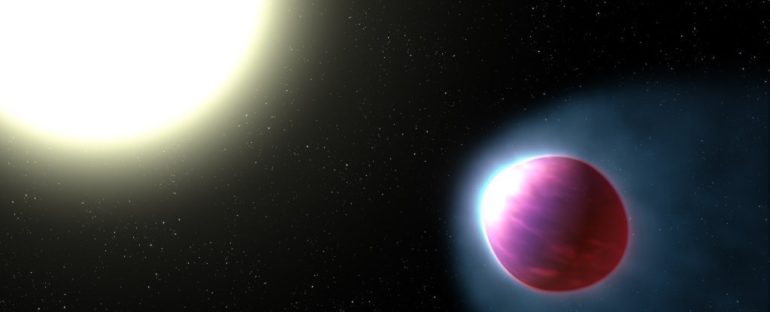Using the light of the star it orbits, astronomers have peered into the atmosphere of an exoplanet 850 light-years away. Not just any exoplanet, but one of the hottest we’ve ever found – and at least seven metals have now been identified floating around its atmosphere as gas.
The exoplanet is WASP-121b, a type of planet we call a hot Jupiter. That’s because it’s a gas giant so close to its star that its temperature rivals that of stars itself; cool stars, to be sure, but stars nevertheless.
WASP-121b is pretty famous, as far as exoplanets go. It was first discovered in 2015, an exoplanet about 1.18 times the mass and 1.81 times the size of Jupiter, on a close orbit of just 1.27 days. Two years later, it became the first exoplanet in whose stratosphere water had been found – although, given the planet’s extreme heat, it’s highly unlikely to be habitable.
Now astronomers have taken a closer look at the exoplanet’s atmosphere, and what they found has surprised them.
At temperatures between 2,500 and 3,000 degrees Celsius (roughly 4,500 and 5,500 degrees Fahrenheit), it isn’t the hottest of these exoplanets that we’ve seen.
But it is so hot that its atmosphere should be a lot simpler than what astronomers have observed in earlier studies – complex molecules should not be able to form in such high temperatures.
These earlier studies suggested that molecules containing the rare metal vanadium and a lack of titanium could explain the spectrum in earlier observations of WASP-121b’s atmosphere.
“Previous studies tried to explain these complex observations with theories that did not seem plausible to me,” said astronomer Jens Hoeijmakers of the Universities of Bern and Geneva in Switzerland.
“But it turned out that they were right. To my surprise, we actually found strong signatures of vanadium in the observations.”
Peering into exoplanet atmospheres is not an easy thing to do. First, you need the exoplanet to pass between us and the star. This is actually a good way to find exoplanets in the first place – you look for really faint, regular dips in starlight to tell you something large is orbiting the star.
To study the atmosphere, you need even fainter signals.
As the exoplanet passes in front of the star, some of the star’s light passes through the atmosphere. Depending on the elements present in the atmosphere, some wavelengths of light will be absorbed and enhanced. If you can take a full spectrum of wavelengths, these will appear as absorption and emission lines.
As you can imagine, the signal isn’t very strong, and there’s a lot of noise. So, for a start, you need good noise reduction tools that aren’t going to destroy the data you need.
The signal can also be magnified and clarified by taking multiple transit spectra and stacking them – so exoplanets with short orbital periods that allow us to take more transit spectra will be easier to analyse. An exoplanet on a 12-year orbit like Jupiter’s would not be an ideal candidate, for example. But WASP-121b’s tight orbit works well.
To obtain a strong spectrum for WASP-121b, Hoeijmakers and his team used three transits previously observed using the HARPS spectrograph instrument on the European Southern Observatory’s La Silla 3.6m telescope, and reprocessed the data.
And they found an interesting metallic cocktail in the exoplanet’s atmosphere. There was the aforementioned vanadium, of course. In addition, the team identified the spectral signatures of iron, chromium, calcium, sodium, magnesium, and nickel. Notably, there’s no titanium – consistent with the earlier findings.
“All metals evaporated as a result of the high temperatures prevailing on WASP-121b, thus ensuring that the air on the exoplanet consists of evaporated metals, among other things,” Hoeijmakers explained.
Hot Jupiters are very mysterious planets, and such analyses of their atmospheres can help us understand them. We don’t know why or how they are so close to their stars, and learning about what’s in their atmospheres can help us figure out if they formed there, or if they migrated inwards from a farther orbit.
But these studies are also helping develop the toolkit for probing planets in search of alien life. What we use to identify iron and sodium today could, with more sensitive equipment, one day help find the molecules produced and used by living organisms, such as oxygen and methane.
“After years of cataloguing what is out there, we are now no longer just taking measurements,” Hoeijmakers said.
“We are really beginning to understand what the data from the instruments show us. How planets resemble and differ from each other. In the same way, perhaps, that Charles Darwin began to develop the theory of evolution after characterising countless species of animals, we are beginning to understand more about how these exoplanets were formed and how they work.”
The research has been published in Astronomy & Astrophysics.



